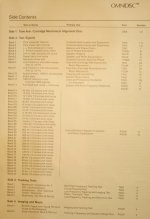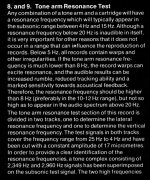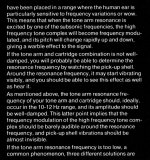I heard back from the PhotoScienceLibrary site regarding the use of a high res SEM photo of a stylus in a groove:
Reproduction fees for non for profit, LP jacket use, Print and digital facsimile, up to 500 units to be produced within one year, Worldwide, Non-exclusive rights. Strictly no other use than permitted. $ 90.00 USD per image
They have a number of interesting photos available: stylus - Keyword search - 48 per page (session default) - first page of 2 - Science Photo Library
I told them I'd get back to them if/when it goes to production.
Reproduction fees for non for profit, LP jacket use, Print and digital facsimile, up to 500 units to be produced within one year, Worldwide, Non-exclusive rights. Strictly no other use than permitted. $ 90.00 USD per image
They have a number of interesting photos available: stylus - Keyword search - 48 per page (session default) - first page of 2 - Science Photo Library
I told them I'd get back to them if/when it goes to production.
Seems like it could be useful. I think (please double check) that @10kHz the groove wavelength will be 51 microns at the outer edge and 21 microns at the inner edge. What signal(s) would help to distinguish distortion problems between inner and outer grooves?But mistracking can also be an issue on inner grooves and there is suspicion that people who report IGD 'may' just be mistracking. Having some high level sweeps or steps round here might be useful?
FWIW, most mastering houses recommend against a lot of HF content on the inner tracks. Outer is 11 1/2"; inner is 4 3/4" diameter.
Please see my post #1063 www.diyaudio.com/forums/analogue-source/313335-test-lp-buy-107.html#post5295308 which addresses exactly this question and proposes test tracks.Seems like it could be useful. I think (please double check) that @10kHz the groove wavelength will be 51 microns at the outer edge and 21 microns at the inner edge. What signal(s) would help to distinguish distortion problems between inner and outer grooves?
The issue isn't one of frequency, it is about instantaneous groove angle for a given programme level, which decreases with spindle radius (linear speed). And about groove curvature for a given instantaneous programme slew rate which decreases with the square of spindle radius (linear speed2).
That IGD shows up at high levels of hf is an artefact of these causal phenomena.
It's far better to test and analyse the causal factors directly, as set out in post #1063. IMHO. Plus it's never been done, AFAIK, and surely that's fun.
LD
Last edited:
I am slightly confused. Normally the low frequency is considered to FM the wanted signal rather than IM. (ah I now see that B&K refer to it as IM). Is the below (from the B&K resonance AES paper) what you mean?
Typically you have both but on a magnitude only instrument they are not separable. I have not shown plots but the transform technique gives both AM and FM at the same time.
That is exactly what is meant.I am slightly confused. Normally the low frequency is considered to FM the wanted signal rather than IM. (ah I now see that B&K refer to it as IM). Is the below (from the B&K resonance AES paper) what you mean?
And all the efforts so far in circular diagrams etc, are showing exactly what LF signal is FM modulating the single tone (f.i. 3150 Hz) on the LP, resulting in the IM products that you see in the B&K plots.
Our hearing system is especially sensitive to FM modulation for frequencies between 2.5 and 10Hz, exactly where the Cart resonance takes place.
As long as the LF IM products are below 0.1%, it will usually be inaudible.
That should be seen as an auditory threshold level.
Our hearing system is also sensitive to AM modulation, but the threshold in percentage lies up to 1000 Hz a factor between 10 to 100 higher as for FM modulation.
Hans
Yes, I agree for FM. One can synth some warble tones and check for oneself. One thing I found really strange is that if one's head is moving even slowly, perception threshold rises massively - ie one can't perceive variation so well...............As long as the LF IM products are below 0.1%, it will usually be inaudible.
That should be seen as an auditory threshold level.
In vinyl playback there shouldn't be much true AM in practice, either. Despite there being plenty of LF baseband signal, it should mostly mix with the carrier without AM modulation. No idea in practice though......if someone has some time one rainy day might be interesting to use Scott's SW which can report AM in principle?Our hearing system is also sensitive to AM modulation, but the threshold in percentage lies up to 1000 Hz a factor between 10 to 100 higher as for FM modulation.
LD
Telarc Omnidisc
Hi All,
I will definitely be in on a group buy, when this project comes to fruition.
I have had the Telarc Omnidisc since roughly 1985, and have found it to be an indispensable tool to set up my turntable/arm/cartridge combinations. This is a two disc boxed set, with the first LP having a totally blank side 1, except for the cartridge alignment groove. Very useful for testing the anti-skate mechanism. Attached is the index page of the Omnidisc User Manual.
I also have the Cardas LP, and a few special and kept-in-mint-condition demo/test records (Moog Synthesizer, Adam Makowicz - The Name Is Makowicz inter alia.)
KevinH
South Africa
Hi All,
I will definitely be in on a group buy, when this project comes to fruition.
I have had the Telarc Omnidisc since roughly 1985, and have found it to be an indispensable tool to set up my turntable/arm/cartridge combinations. This is a two disc boxed set, with the first LP having a totally blank side 1, except for the cartridge alignment groove. Very useful for testing the anti-skate mechanism. Attached is the index page of the Omnidisc User Manual.
I also have the Cardas LP, and a few special and kept-in-mint-condition demo/test records (Moog Synthesizer, Adam Makowicz - The Name Is Makowicz inter alia.)
KevinH
South Africa
Attachments
Our hearing system is especially sensitive to FM modulation for frequencies between 2.5 and 10Hz, exactly where the Cart resonance takes place.
As long as the LF IM products are below 0.1%, it will usually be inaudible.
That should be seen as an auditory threshold level.
Which is why I am planning to experiment with higher resonant frequencies. On another forum, where scientific types are expunged the answer is always to add more mass to the headshell. I'm just not convinced that 7Hz resonance is EVER good. But I would like to repeat the B&K measurements with adjustable damping.
.if someone has some time one rainy day might be interesting to use Scott's SW which can report AM in principle?
LD
I've done it, the magnitude of the Hilbert transform is the amplitude and the derivative of the unwrapped phase is the instantaneous frequency. I'll try and post a plot from one of the previous test runs.
I'm going to be doing some work while on holiday the next month or so redoing the filtering to accommodate the IEC wow and flutter and including a window for the spectrum and other information.
Thanks for the list, KevinH. I've wondered about putting out of phase or uncorrelated pink noise on the LP. I find those to be useful digital test signals but don't know how well they would cut in the low frequencies. TBD. Do you know what the absolute phase signal is? Maybe a sawtooth?
These days 1/3 octave bands of pink may not be as useful as they once were, now that we had computer analysis at hand.
These days 1/3 octave bands of pink may not be as useful as they once were, now that we had computer analysis at hand.
I agree. I recommend a 3150Hz carrier with a superimposed LF sweep or discreet LF spot frequencies. 'Tickling' the arm/cartridge at the LF resonance this way really stirs up FM mud quickly, and some arm/cart combinations deteriorate more rapidly than others. Such a test is more useful than a silent groove to separate the wheat from the chaff.That's not what I had in mind.
I wanted to see what the Arm/Cart is additionally contributing to IM distortion, which cannot be simply predicted by looking at the spectrum of a silent track.
Ray K
Yes, I agree. This was demonstrated on a different thread a few months back as highly effective.I agree. I recommend a 3150Hz carrier with a superimposed LF sweep or discreet LF spot frequencies. 'Tickling' the arm/cartridge at the LF resonance this way really stirs up FM mud quickly, and some arm/cart combinations deteriorate more rapidly than others. Such a test is more useful than a silent groove to separate the wheat from the chaff.
Ray K
In post #654 such a test was suggested and included in the candidate list as a set of highly modulated bursts with a swept lf repetition frequency. But a continuous tone sweep could be just as effective, methinks. Originally it was lateral and vertical stimulus as separate tests, IIRC.
Such a test could go anywhere on the record. Sweep or spot frequencies need to progress slowly enough so that polar plot SW can determine well resolved results. It might take up, relatively, quite a bit of time on the record. But there should be plenty of inner groove space, methinks.
Sweep range 5Hz to 24Hz perhaps?
LD
Last edited:
What ratio? Or 3150 in on channel, the sweep in the other?I agree. I recommend a 3150Hz carrier with a superimposed LF sweep or discreet LF spot frequencies.
The Telarc disk uses a 4-125Hz sweep, is that too broad?
Let me know, along with the duration, and I'll make us one.
What ratio? Or 3150 in on channel, the sweep in the other?
The Telarc disk uses a 4-125Hz sweep, is that too broad?
Let me know, along with the duration, and I'll make us one.
My gold standard for evaluating FM susceptability is the Ortofon Test Record #0001 and #0002, both lonnng out of print. Ortofon cut 2 tracks, one for vertical and one for horizontal. They superimposed a combination of 2349Hz and 2960Hz on a subsonic test sweep from 4 to 25Hz. The resonance test was for subjective evaluation and did not require the user to possess or use any instrumentation. I attached some of the liner notes that describe these test bands. Although the intent of the tone complex was to detrmine the mass/compliance resonance frequency (Fres), the mechanism by which the tone complex made the Fres point audible is the FM warble that the user heard when the vibrating arm caused stylus scrubbing. I think the DIY group's standardizing on 3150Hz would also accomplish the desired audible objective, plus the DIY tone complex would allow objective analysis of FM via software.
Please be aware that, for whatever baffling reason, the currently re-issued version of the Ortofon test record does NOT have these resonance test bands! (And neither does the out-of-print Ortofon Test Record #0003)
Ray K
http://www.diyaudio.com/forums/attachment.php?attachmentid=654473&stc=1&d=1515019840
http://www.diyaudio.com/forums/attachment.php?attachmentid=654474&stc=1&d=1515019840
Attachments
Ray,
I still don't get what the advantage would be to have a combination of 3150 Hz with a superimposed sweep from 4-25 Hz if the only purpose is to find out what Fres of the Cart/Arm is.
Just having a sweep from 4-25 Hz will do the same IMO.
And as we have seen in various plots, a single 3150 Hz tone will also reveal Fres in the IM spectrum.
My proposal to have a strong and a weak 3150 Hz signal, separates the TT noise without Fres from TT + Fres.
I do not see this info popping up with the 4-25 Hz chirp.
And on top of that, to know Fres as just a frequency seems less important as it is to see what it does to the IM distortion.
Hans
I still don't get what the advantage would be to have a combination of 3150 Hz with a superimposed sweep from 4-25 Hz if the only purpose is to find out what Fres of the Cart/Arm is.
Just having a sweep from 4-25 Hz will do the same IMO.
And as we have seen in various plots, a single 3150 Hz tone will also reveal Fres in the IM spectrum.
My proposal to have a strong and a weak 3150 Hz signal, separates the TT noise without Fres from TT + Fres.
I do not see this info popping up with the 4-25 Hz chirp.
And on top of that, to know Fres as just a frequency seems less important as it is to see what it does to the IM distortion.
Hans
One advantage is that, by looking at FM effect of headshell motion on a 3150Hz carrier, one does not rely on absence of high pass filter roll-off in f amplitude response of preamp and/or cart gen looking a baseband lf. Which factors vary from rig to rig. This is helpful when evaluating Q of the resonance - the parameter that really matters.I still don't get what the advantage would be to have a combination of 3150 Hz with a superimposed sweep from 4-25 Hz if the only purpose is to find out what Fres of the Cart/Arm is.
Just having a sweep from 4-25 Hz will do the same IMO.
Any difference between strong & weak carrier tone results is difficult to explain IMO. But could be due to increase in random friction/drag in the presence of modulated grooves I suppose. So if there's space, I vote to keep the split levels in anyway.And as we have seen in various plots, a single 3150 Hz tone will also reveal Fres in the IM spectrum. My proposal to have a strong and a weak 3150 Hz signal, separates the TT noise without Fres from TT + Fres.
LD
Last edited:
I still don't get what the advantage would be to have a combination of 3150 Hz with a superimposed sweep from 4-25 Hz if the only purpose is to find out what Fres of the Cart/Arm is.
Just having a sweep from 4-25 Hz will do the same IMO.
Hans
If you have testing instrument, you may see the cartridge mis-tracking on your instrument. But if a sweep combined 4-25 Hz with higher frequency, you can actually hear the distortion without any instrument. It is not necessary to have 3150 Hz combined with 4-25 Hz, 1k should work, too. Please see the video I tested my arm at resonance frequency. The arm mis-tracked at 5 Hz. It caused distortion at 1 kHz so you can hear it.
YouTube
I also saw somewhere that 1 kHz is a pilot frequency. You can't cut 4-25 Hz without a pilot frequency. But I don't fully understand why.
Last edited:
- Home
- Source & Line
- Analogue Source
- Test LP group buy



